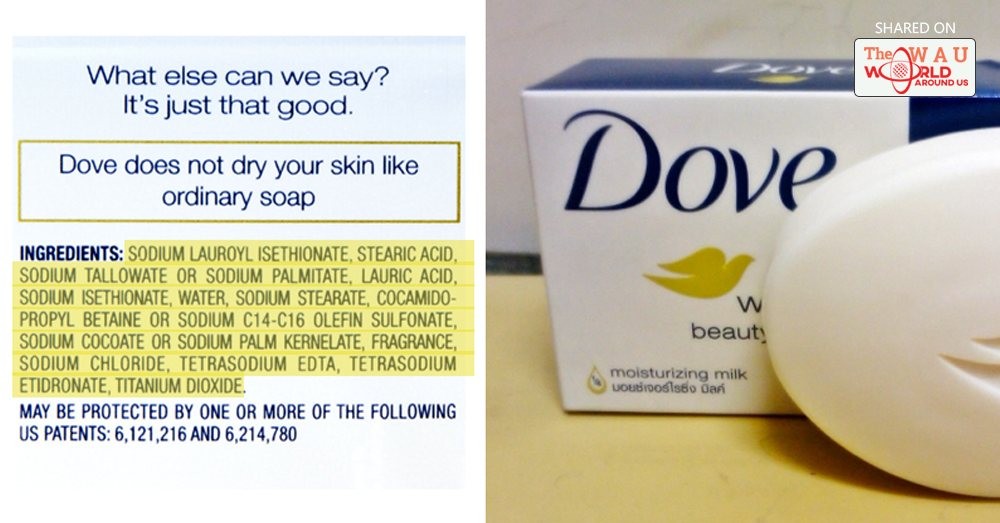Nowadays, we are constantly struggling to reach the high standards that fashion and modern advertising impose to as a perfection. We started hating every single blemish or wrinkle on our faces, we began photoshopping our bodies, we hate our frizzy, curly, thin hair etc.
On the other hand, Dove had a different campaign, which included real women, with their real one bodies. These people talk about their insecurities about their looks and the way they accepted their natural beauty.
Therefore, we would rather buy products that say that we are already beautiful than cosmetics that say we must use them to become pretty. Yet, we expect that the first ones are filled with natural ingredients, but apparently, they are loaded with toxic components!
The brand Dove started in 1957 when the Lever Brothers produced an original ‘beauty bar.’ The advertisement claimed that their products were ‘much better for your skin’ than other soaps and that it contained ‘one-quarter cleansing cream.’
Since then, the logo featured the bird silhouette we see today as well. Yet, the models then were typical for the time, girly, with red lips. Their ads began featuring real women in the late 60s, who testified in front of a supposedly hidden camera about the moisturizing effects of the soap.
After two decades, the company started promoting inner beauty, and the ad focused on one woman ‘Jean Shy’ who reflects on a compliment given to her about her skin after using Dove.
In 1991, the “Litmus tests’ started, and the soap was advertised as low alkaline. ‘Dove is mildest. Bar none.’ The company started producing body lotions, shampoo, cleansers, deodorants, hand and face care.
In 2004, they launched the official campaign for real beauty.
In 2005, the Dove Self-Esteem Fund was founded to fight eating disorders, and they released videos which showed the unrealistic portrayal of beauty from the media, and the pressure from the press which makes girls insecure and unconfident.
Nowadays, it is the leading cleansing brand in the world, having sales over $2.5 billion U.S. a year, in over 80 countries.
However, research has found numerous toxic ingredients in their products:
Deep Moisture Body Wash
The company claims that this product is:
- Dermatologist recommended
- Excellent for everyday use
- Nourishes deep into the surface layers of the skin
- NutriumMoisture™ technology provides natural nutrients to the skin
- Mild, gentle formula that soothes the skin
- Softer, smoother skin after just one shower
- Maintains the moisture of the skin during cleanse
However, this is the list of ‘natural nutrients’ inside it:
Water (Aqua), Cocamidopropyl Betaine, Sodium Hydroxypropyl Starch Phosphate, Lauric Acid, Sodium Lauryl Glycinate, Sodium Lauroyl Isethionate, Hydrogenated Soybean Oil, Glycine Soya (Soybean) Oil Or Helianthus Annuus (Sunflower) Seed Oil, Sodium Chloride, Glycerin, Fragrance (Perfume), Guar Hydroxypropyltrimonium Chloride, Dmdm Hydantoin, Stearic Acid, Citric Acid, Bht, Tetrasodium Edta, Methylisothiazolinone, Iodopropynyl Butylcarbamate.
Dove Daily Moisture Shampoo
The product supposedly provides the following benefits:
- It is suitable for everyday use
- Formulated with Pro-Moisture Complex
- Makes the hair silky and manageable
- Nourishes the hair and makes it healthier
- Protects it from daily wear and tear
- Makes the hair softer and 5X smoother than non-conditioning shampoo
Yet, these are the ingredients of this shampoo:
Water (Aqua), Sodium Laureth Sulfate, Glycol Distearate, Cocamidopropyl Betaine, Sodium Chloride, Fragrance (Parfum), Glycerin, Dimethicone, Dimethiconol, Acrylates/Beheneth-25 Methacrylate Copolymer, Styrene/Acrylates Copolymer, Guar Hydroxypropyltrimonium Chloride, Citric Acid, Tetrasodium Edta, Amodimethicone, Dmdm Hydantoin, Peg-45M, Tea-Dodecylbenzenesulfonate, Cocamide Mea, Lysine HCl, Arginine, Peg-9M, Cetrimonium Chloride, Ppg-9, Propylene Glycol, Methylchloroisothiazolinone, Methylisothiazolinone, Mica (Ci 77019), Titanium Dioxide (Ci 77891), Yellow 5 (Ci 19140), Red 33 (Ci 17200).
Dove White Beauty Bar
The original Dove product has not been changed over the years, and the company claims that it is:
- Dermatologically tested and recommended
- Excellent for everyday use on the body, face, and hands
- Does not dry the skin
- Contains ¼ moisturizing cream and mild cleansers which moisten the skin
- Classic moisturizing formula
- Makes the skin softer, smoother and radiant
Yet, this is the list of the ingredients:
Sodium Lauroyl Isethionate, Stearic Acid, Sodium Tallowate Or Sodium Palmitate, Lauric Acid, Sodium Isethionate, Water, Sodium Stearate, Cocamidopropyl Betaine, Sodium Cocoate Or Sodium Palm Kernelate, Fragrance, Sodium Chloride, Tetrasodium Edta, Tetrasodium Etidronate, Titanium Dioxide (Ci 77891).
To clarify the effects of these products, we will provide a more detailed explanation of their ingredients:
Fragrance/Perfume is scientifically confirmed to raise the risk of skin sensitivities, as it irritates the skin and is the leading cause of dermatitis from cosmetic use.
Methylisothiazolinone – This chemical has been found to lead to neurodegenerative disorders and seizures.
Sodium Tallowate – Sodium Tallowate is derived from the fatty tissue of cattle, so vegans should avoid it.
Sodium Laureth Sulfate – More than 16,000 studies have been evaluating the cumulative effect and long-term exposure of SLS and have found that it is related to:
- Developmental/reproductive toxicity
- Irritation of the skin and eyes
- Possible mutations and cancer
- Organ toxicity
-Neurotoxicity, endocrine disruption, ecotoxicology, and biochemical or cellular changes
-Tetrasodium Edta is a product derived from formaldehyde, which is a well-known carcinogen. It is a penetration enhancer, so it dissolves the protective skin barrier, opening the way for other toxins to enter the tissue and the bloodstream.
Share This Post















